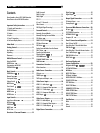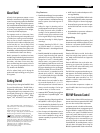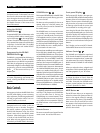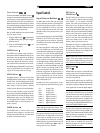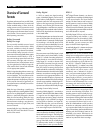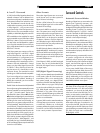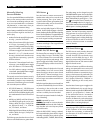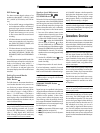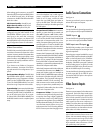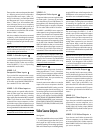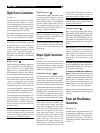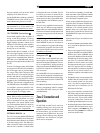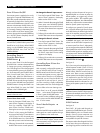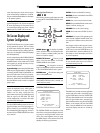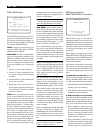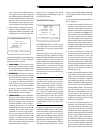
18
When making signal connections, connect LEFT
channels to LEFT channel jacks and RIGHT chan-
nels to RIGHT channel jacks. All RCA-type
connections on the RSP-1066 follow these stan-
dard color codes:
Left channel audio: white RCA jack
Right channel audio: red RCA jack
Composite video: yellow RCA jack
NOTE
: Each source input must be properly
configured using the INPUT MENU of the
ON-SCREEN DISPLAY system. We recom-
mend going to this menu after connecting
each source to configure it as desired. See
the INPUT MENU topic of the On-Screen Dis-
play/Configuration section for information.
Video Connections
The RSP-1066 provides S-Video and Compo-
nent Video connections for those who wish to
use them. However, standard Composite video
cables provide excellent picture quality in most
systems and their use for all input and output
connections will simplify installation and con-
figuration of the unit.
If you choose to use S-Video or Component
Video connections, be aware of the follow-
ing implications for the configuration of your
system:
On Screen Menu Display: The RSP-1066
ON-SCREEN MENU system is available for
all inputs when using a Composite or S-Video
cable from the TV MONITOR outputs to the
TV set. The ON-SCREEN MENU is not avail-
able when using Component video cables.
System Set-Up: System setup should be done
while using a Composite video or S-Video cable
connecting the RSP-1066 TV MONITOR out-
puts to the video inputs of the TV or projec-
tor. Select OSD ( ON-SCREEN MENU) from
the RR-969 remote control to complete system
setup.
NOTE
: On a PAL standard monitor, the OSD
cannot be displayed until a video signal is
present, irrespective of the type of video
cables in use. For setup, connect the video
output from your DVD player and select its
input on the RSP-1066. The OSD will be dis-
played as an overlay to the video signal from
the DVD player.
Composite and S-Video: With certain ex-
ceptions, a system should be connected with
either all Composite or all S-Video cables.
S-Video signals from sources cannot be sent
to a TV set from the RSP-1066 TV MONITOR
outputs with a Composite video cable. Con-
versely, Composite video signals from sources
cannot be sent to a TV set from the RSP-1066
TV MONITOR outputs with an S-Video cable.
Therefore, Composite and S-Video connections
cannot be “mixed” in a system.
However, both Composite and S-Video cables
may be connected from the RSP-1066 TV MONI-
TOR outputs to both Composite and S-Video in-
puts on a TV or projector. This dual connection
from the RSP-1066 will provide limited S-Video
capability in a system that is predominantly con-
nected with Composite video cables.
When both Composite and S-Video cables are
connected from the same source, both Com-
posite and S-Video signals are available at
the RSP-1066’s TV MONITOR outputs, allowing
the selection of the desired signal with the TV
input selector. The Composite video signal is
available at the REC Out for recording. This
dual connection can be used to provide video
taping in a system that is predominantly con-
nected with S-Video cables, but also includes
a VCR with Composite video.
Component Video: Component Video
connections can significantly improve the pic-
ture quality when using a digital “high-defini-
tion” television monitor and a DVD player’s
progressive scanning feature. They provide little
benefit with standard analog TV monitors. Their
use will almost certainly require running mul-
tiple outputs to the TV and switching between
the TV’s various inputs when changing sources.
Audio Source Connections
See Figure 4.
Connect your audio-only source components
to these RCA inputs and outputs:
CD Inputs
Connect the left and right analog outputs from
your CD player to the input jacks labeled CD.
TUNER Inputs
Connect the left and right analog outputs from
your tuner to the input jacks labeled TUNER.
TAPE Inputs and Outputs
The RSP-1066 provides a pair of inputs and
a pair of record outputs for connecting an ana-
log audio tape deck.
The analog source signal available for record-
ing at the TAPE outputs is selected with the REC
button on the front-panel (or the ZONE but-
ton on the remote) and its label appears in
the display. If the TAPE input signal is selected
as the recording source, its signal will not be
available at the TAPE output, but will be avail-
able at the VIDEO outputs for recording.
Connect the left and right analog
outputs
from
an audio tape deck to the TAPE IN jacks.
Connect the TAPE OUT jacks to the
inputs
on
the audio tape deck.
Video Source Inputs
See Figure 4.
There are input connections for five video source
components. Each of the five provides a pair
of RCA inputs for analog audio signals. Each
of the five also provides a choice of an RCA
composite video input or S-Video input for the
video signal from the source component. In
addition, two of the video source inputs (Video
1 and Video 2) also feature Component Video
input connections as an alternative to the com-
posite video or S-Video connections.
NOTE
: There is no need to use more than one
type of video connection from a source com-
ponent. We recommend selecting one type
of video connection and using it for all video
inputs and outputs. As a general rule, using
RCA composite video connections will sim-
plify system setup and operation.
RSP-1066 Surround Sound Processor



